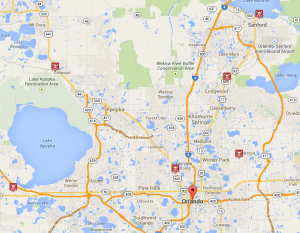Unfortunately, there are six known toxic waste sites in the Orlando metropolitan area. The good news is that most have been cleaned up to meet the remediation standards of the Environmental Protection Agency (EPA). You can see the  locations of the toxic waste sites for yourself using our MoveMap. In this blog post we’ll discuss three of these, telling you why it’s a designated Superfund site and what its cleanup status is.
locations of the toxic waste sites for yourself using our MoveMap. In this blog post we’ll discuss three of these, telling you why it’s a designated Superfund site and what its cleanup status is.
According to the EPA, the City Industries site is a one acre former hazardous waste recycling compound located at 3920 Forsyth Rd Orlando, FL 32792. The site was abandoned years ago, but when operational, City Industries Inc. handled and disposed of a variety of waste chemicals some of the chemicals were disposed of improperly, leading to on-site soil and groundwater contamination with volatile organic compounds. In 1983, the state of Florida actually ordered City Industries to cease operation, at which point the compound was abandoned. Around 1,200 barrels of hazardous waste and thousands of gallons of sludge (in holding tanks) were simply left on the site. The property was added to the National Priority List (NPL) in 1989, making it eligible for cleanup. After being added to the list, the EPA treated over 1,600 tons of contaminated soil and built a ground water pump and treatment system. The site has been reclaimed and the area is now used for commercial and retail space.
The Chevron Chemical Co site located at 3100 Orange Blossom Tr. Orlando, FL 32804 consists of around 4 acres of industrial property where groundwater and soil contamination has occurred. A variety of activities took place at the Chevron center and the EPA identified several contaminants of concern which include pesticides, volatile organic compounds (such as xylene) and metals. Fortunately, the EPA took action to clean up the site they state that the level of contamination at the property does not pose a threat to people living nearby. In 1991 & 1992 the Chevron demolished all buildings on the property. They also removed around 18,000 tons of soil which was contaminated with pesticides and treated ground water during the excavation. Ground water monitoring wells were also installed to keep tabs on the contamination. Monitoring and cleanup operations are ongoing.
General Dynamics is situated in Longwood at 1333 North US Highway 17/92 Longwood, FL 32750. Circuit boards and other electronics were manufactured on the property from the mid ‘60s to the early ‘80s. Currently, the site is unoccupied and has been placed on the National Priority List due to soil and groundwater contamination. From an environmental perspective, the area is fairly complicated since another manufacturing facility called Sprague Electric Company has also contributed to groundwater and soil contamination in the region. The EPA believes the groundwater plumes from the two sites may have merged. Fortunately, they do not believe the site currently represents a threat to people living and working nearby. However, the activities performed on the property have damaged the environment. The surficial and part of the Floridan (deeper) aquifers have been contaminated with trichloroethylene (TCE) and this groundwater contamination could threaten the City of Winter Spring’s public water supply if not dealt with. The plume has not become an issue yet and Winter Springs routinely checks its water supply for contamination. In terms of cleanup progress, the Sprague Site has been worked on and monitored for years, but the site investigation and cleanup efforts for General Dynamics are just getting underway.
While sites containing hazardous chemicals are scary and undesirable to live near they are also a part of our modern society, whether we like it or not. The best thing we can do to protect our families and allay our fears is simply to educate ourselves. If you’re concerned about Superfund, AKA toxic waste, sites in your area, we encourage you to take a look at our MoveMap and see if there are any sites located near your home. After that, you can check out the EPA’s website which contains detailed information on all Superfund sites and contaminants present at each of them.

